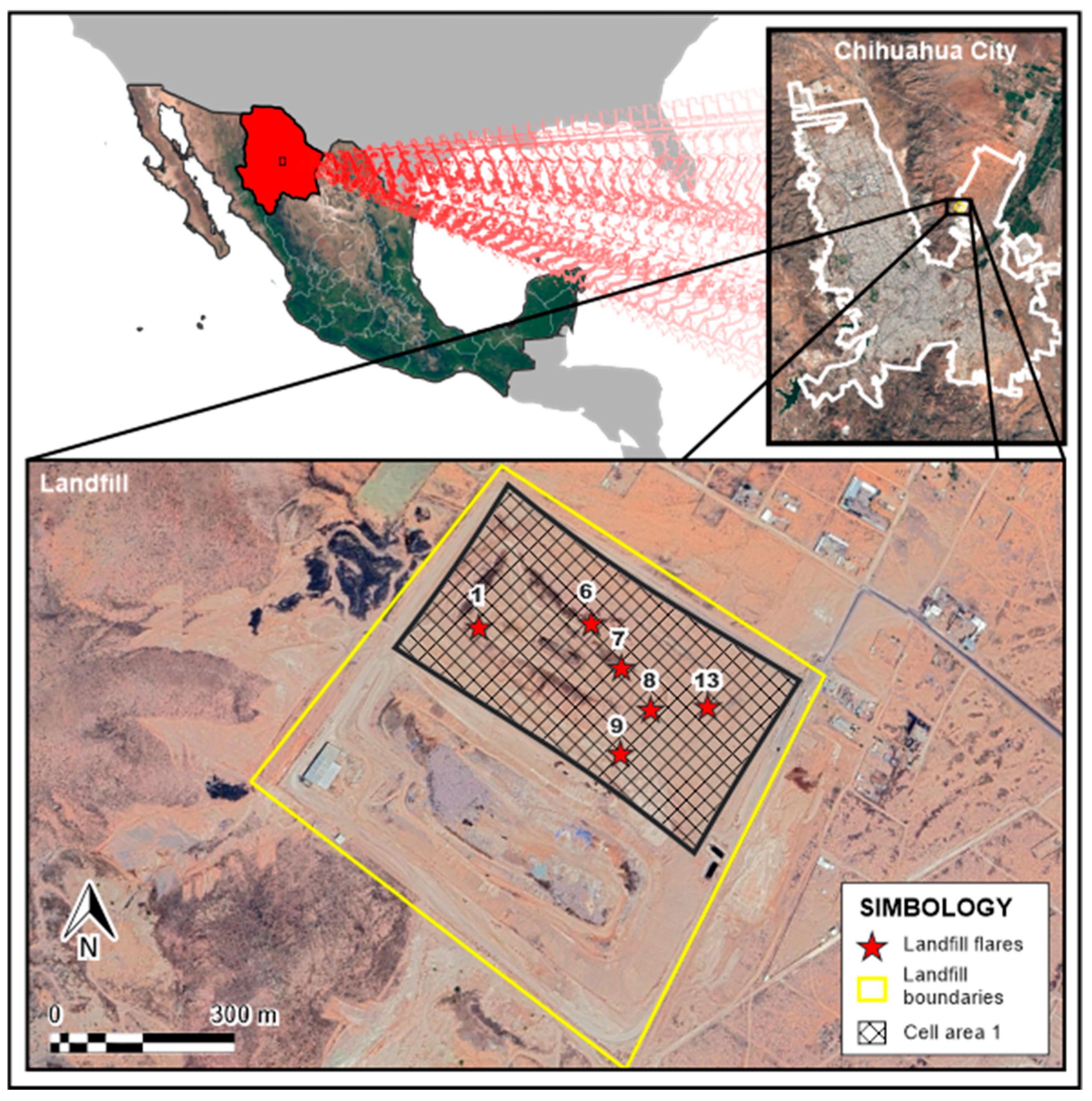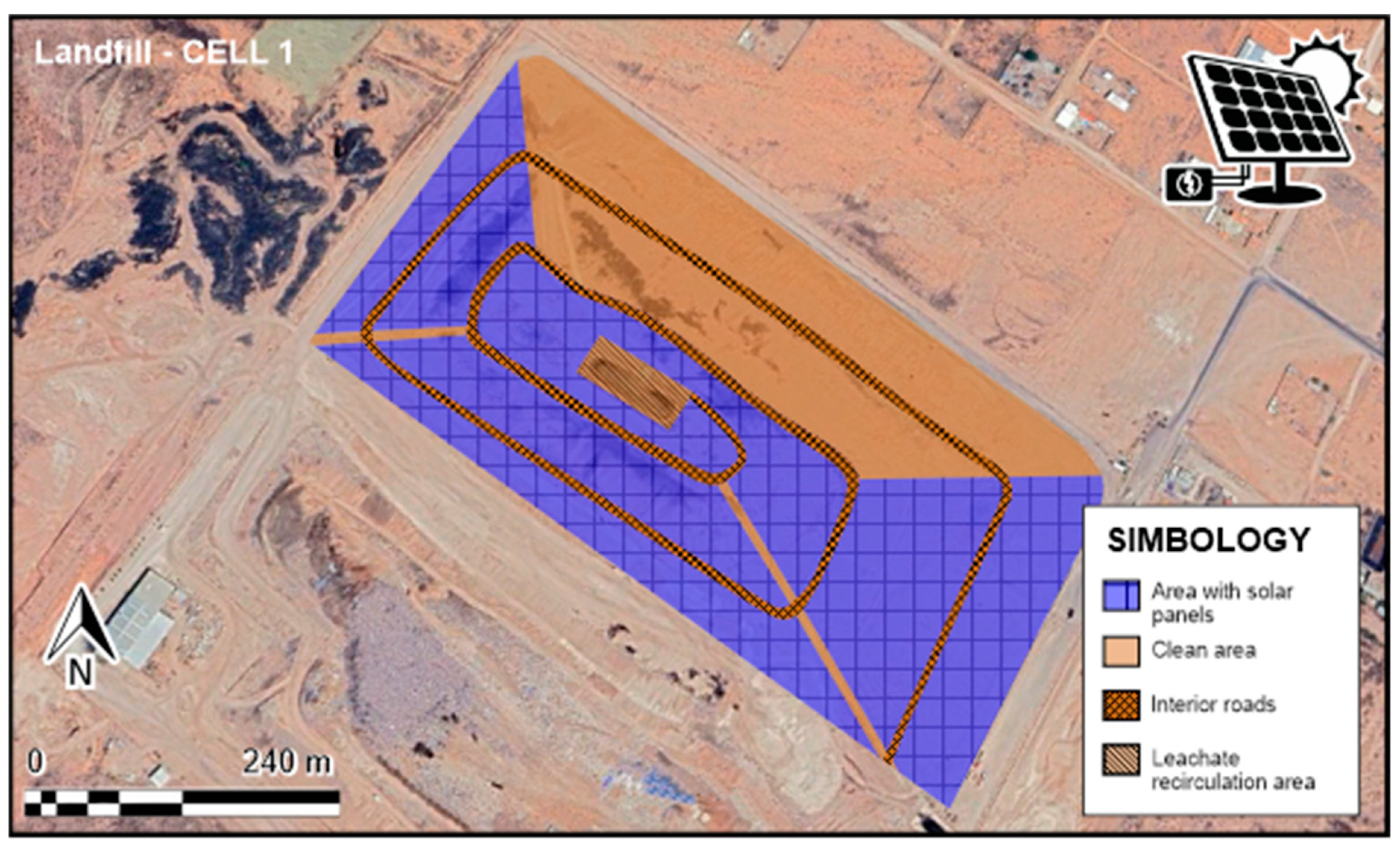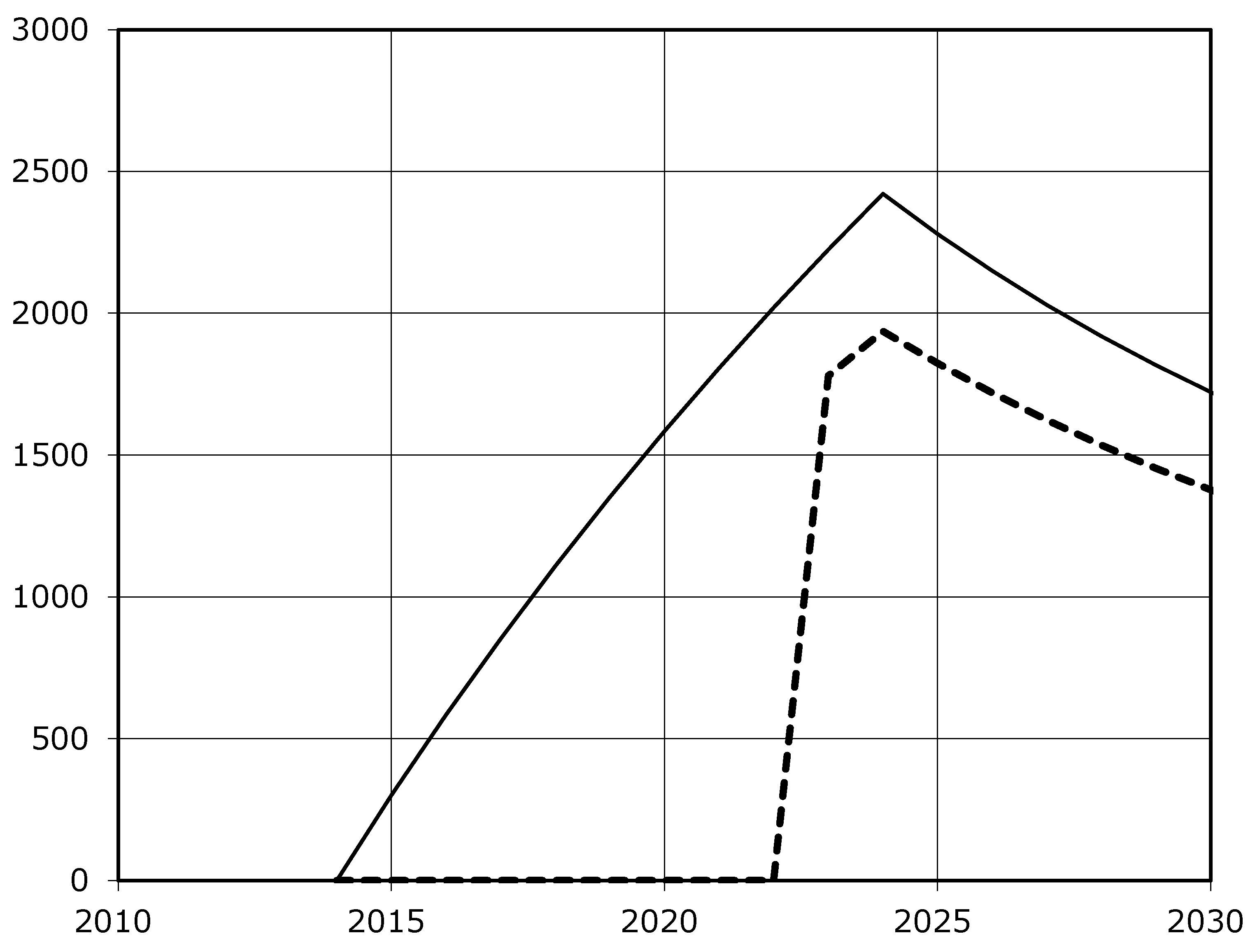Evaluation of Energy Potential in a Landfill Through the Integration of a Biogas–Solar Photovoltaic System
Abstract
1. Introduction
2. Materials and Methods
3. Results and Discussion
3.1. Cell 1 of the Metropolitan Landfill
3.1.1. Biogas Estimation (Cell 1)
3.1.2. Photovoltaic System in the Landfill Site (Cell 1)
3.2. Cell 2 of the Metropolitan Landfill
3.2.1. Biogas Estimation (Cell 2)
3.2.2. Photovoltaic System in the Landfill Site (Cell 2)
4. Conclusions
- This study demonstrates that biogas is a viable and sustainable source of clean energy, with generation projections varying between the LandGEM and MMB models, highlighting its potential for energy recovery and utilization.
- The integration of hybrid biogas–solar PV systems in landfills enhances waste management efficiency and renewable energy generation, fostering innovation in the energy sector and promoting sustainable practices. Such systems also generate employment opportunities in waste management and renewable energy industries, emphasizing their socioeconomic benefits.
- Mathematical models and simulation tools are essential resources for the planning, design, and optimization of hybrid biogas–solar PV systems. These tools support the maximization of renewable energy output and reduce the dependence on conventional energy sources, aligning with global renewable energy transition goals.
- The implementation of advanced waste separation and recovery techniques, supported by robust recycling infrastructures and sustainable markets for recycled products, is critical for comprehensive urban waste management.
- Enhanced final cover systems significantly reduce fugitive emissions and improve biogas production efficiency. The quality of these covers and the selection of suitable materials play a pivotal role in optimizing the performance of biogas capture systems.
- Feasibility studies for the certification of carbon credits generated through biogas utilization are recommended. These certifications offer potential economic benefits, mitigate greenhouse gas emissions, and contribute to improved air quality and public health.
- Partial closures of landfill cells, combined with the installation of gas flares or biogas burners, are necessary to reduce fire risks, enhance biogas collection, and prevent emissions into the atmosphere. Implementing a leveling plan to avoid terrain depressions is critical for the efficient installation of solar panels, reducing additional preparation costs and ensuring optimal energy generation.
- Comparative assessments of polycrystalline silicon and thin-film solar panels reveal that thin-film panels require minimal land preparation and offer a cost-effective balance between energy production and installation requirements.
- Long-term studies on the economic and operational feasibility of hybrid biogas–solar PV systems are essential to guide effective implementation strategies. The findings emphasize the critical role of integrating biogas and solar PV technologies within landfill operations to advance sustainable energy solutions and enhance urban resilience. Incorporating these technologies into urban policies and regulatory frameworks has the potential to deliver significant environmental, economic, and social benefits. Furthermore, policy interventions should prioritize financial incentives such as subsidies, tax reductions, and streamlined permitting processes to facilitate widespread adoption. Establishing mandatory waste-to-energy targets and integrating renewable energy credits within carbon trading systems could further support the transition to sustainable urban waste management, fostering innovation and reducing dependence on conventional energy sources.
Supplementary Materials
Author Contributions
Funding
Data Availability Statement
Acknowledgments
Conflicts of Interest
References
- Rueda-Avellaneda, J.F.; Rivas-García, P.; Gomez-Gonzalez, R.; Benitez-Bravo, R.; Botello-Álvarez, J.E.; Tututi-Avila, S. Current and prospective situation of municipal solid waste final disposal in Mexico: A spatio-temporal evaluation. Renew. Sustain. Energy Transit. 2021, 1, 100007. [Google Scholar] [CrossRef]
- Lima, R.; Santos, A.; Pereira, C.; Flauzino, B.; Pereira, A.; Nogueira, F.; Valverde, J. Spatially distributed potential of landfill biogas production and electric power generation in Brazil. Waste Manag. 2017, 74, 323–334. [Google Scholar] [CrossRef] [PubMed]
- Vallero, D. Air Pollution Calculations: Quantifying Pollutant Formation, Transport, Transformation, Fate and Risks, 2nd ed.; Elsevier: Amsterdam, The Netherlands, 2019. [Google Scholar] [CrossRef]
- Verma, R.L.; Borongan, G. Emissions of greenhouse gases from municipal solid waste management system in Ho Chi Minh City of Viet Nam. Urban Sci. 2022, 6, 78. [Google Scholar] [CrossRef]
- Panesso, A.F.; Cadena, J.A.; Flórez, J.J.M.; Ordoñez, M.C. Análisis del biogás captado en un relleno sanitario como combustible primario para la generación de energía eléctrica. Sci. Tech. 2011, 17, 23–28. [Google Scholar] [CrossRef]
- Nikkhah, A.; Khojastehpour, M.; Abbaspour-Fard, M. Hybrid landfill gas emissions modeling and life cycle assessment for determining the appropriate period to install biogas system. J. Clean. Prod. 2018, 185, 772–780. [Google Scholar] [CrossRef]
- Biancini, G.; Marchetti, B.; Cioccolanti, L.; Moglie, M. Comprehensive Life Cycle Assessment Analysis of an Italian Composting Facility concerning Environmental Footprint Minimization and Renewable Energy Integration. Sustainability 2022, 14, 14961. [Google Scholar] [CrossRef]
- Mønster, J.; Samuelsson, J.; Kjeldsen, P.; Scheutz, C. Quantification of methane emissions from 15 Danish landfills using the mobile tracer dispersion method. Waste Manag. 2015, 35, 177. [Google Scholar] [CrossRef] [PubMed]
- Escamilla-García, P.E.; Jiménez-Castañeda, M.E.; Fernández-Rodríguez, E.; Galicia-Villanueva, S. Feasibility of energy generation by methane emissions from a landfill in southern Mexico. J. Mater. Cycles Waste Manag. 2020, 22, 295–303. [Google Scholar] [CrossRef]
- Pérez, G.B.M.; Saavedra, J.J.Q.; Huaman, Y.M.V. Cálculo de la generación de biogás para el relleno sanitario de la ciudad de Juliaca, utilizando el modelo LandGEM Versión 3.02 de la USEPA y estimación del potencial de producción eléctrica. Rev. Investig. Cienc. Tecnol. Desarro. 2018, 4, 42–55. [Google Scholar] [CrossRef]
- Ramprasad, C.; Teja, H.C.; Gowtham, V.; Vikas, V. Quantification of landfill gas emissions and energy production potential in Tirupati Municipal solid waste disposal site by LandGEM mathematical model. MethodsX 2022, 9, 101869. [Google Scholar] [CrossRef]
- Scheutz, C.; Kjeld, A.; Fredenslund, A.M. Methane emissions from Icelandic landfills–A comparison between measured and modelled emissions. Waste Manag. 2022, 139, 136–145. [Google Scholar] [CrossRef] [PubMed]
- Srivastava, A.N.; Chakma, S. Quantification of landfill gas generation and energy recovery estimation from the municipal solid waste landfill sites of Delhi, India. Energy Sources Part A Recover. Util. Environ. Eff. 2020, 46, 7453–7466. [Google Scholar] [CrossRef]
- Colomer Mendoza, F.J.; García Darás, F.; Esteban Altabella, J.; Robles Martínez, F.; Aranda, G. Emisiones gaseosas de un relleno sanitario en México, comparación con los modelos de generación de biogás. Rev. Int. Contam. Ambie. 2016, 32, 113–122. [Google Scholar] [CrossRef]
- Urrego-Martínez, E.; Rodríguez-Miranda, J.P. Aplicación de las metodologías EPA, mexicano e IPCC para la estimación de biogás, caso de estudio relleno sanitario Doña Juana, Bogotá-Colombia. Univ. Salud 2016, 18, 338–344. [Google Scholar] [CrossRef]
- Cárdenas-Moreno, P.R.; Piña-Guzmán, A.B.; Robles-Martínez, F. Estimación del biogás generado en sitios de disposición final del Estado de México. Rev. Int. Contam. Ambie. 2021, 37, 27–38. [Google Scholar] [CrossRef]
- Barragán-Escandón, A.; Olmedo Ruiz, J.M.; Curillo Tigre, J.D.; Zalamea-León, E.F. Assessment of power generation using biogas from landfills in an equatorial tropical context. Sustainability 2020, 12, 2669. [Google Scholar] [CrossRef]
- Jain, P.; Powell, J.; Townsend, T.G.; Reinhart, D.R. Air permeability of waste in a municipal solid waste landfill. J. Environ. Eng. 2005, 131, 1565–1573. [Google Scholar] [CrossRef]
- Stoltz, G.; Gourc, J.P.; Oxarango, L. Liquid and gas permeabilities of unsaturated municipal solid waste under compression. J. Contam. Hydrol. 2010, 118, 27–42. [Google Scholar] [CrossRef]
- Juca, J.F.T.; Maciel, F.J. Gas permeability of a compacted soil used in a landfill cover layer. Unsaturated Soils 2006, 2006, 1535–1546. [Google Scholar] [CrossRef]
- Jung, Y.; Imhoff, P.; Augenstein, D.; Yazdani, R. Mitigating methane emissions and air intrusion in heterogeneous landfills with a high permeability layer. Waste Manag. 2011, 31, 1049–1058. [Google Scholar] [CrossRef]
- Gu, G.; Song, Z.; Lu, B.; Deckard, Y.; Lei, Z.; Sun, X. Energetic and financial analysis of solar landfill project: A case study in Qingyuan. Int. J. Low-Carbon Technol. 2022, 17, 214–221. [Google Scholar] [CrossRef]
- Szabó, S.; Bódis, K.; Kougias, I.; Moner-Girona, M.; Jäger-Waldau, A.; Barton, G.; Szabó, L. A methodology for maximizing the benefits of solar landfills on closed sites. Renew. Sustain. Energy Rev. 2017, 76, 1291–1300. [Google Scholar] [CrossRef]
- Zhu, M.; Ayers, M.; Dortland, G. Field Applications of PV Solar Systems on Landfills. In Proceedings of the 2023 Middle East and North Africa Solar Conference (MENA-SC), Dubai, United Arab Emirates, 15–18 November 2023; pp. 1–3. [Google Scholar] [CrossRef]
- Jacob, B.A.; Ayers, M.R. Landfill Solar: Trash to Treasure. Energy Eng. 2018, 115, 37–47. [Google Scholar] [CrossRef]
- Bambokela, J.E.; Belaid, M.; Muzenda, E.; Nhubu, T. Developing a pilot biogas-solar PV system for farming communities in Botswana: Case of Palapye. Procedia Comput. Sci. 2022, 200, 1593–1604. [Google Scholar] [CrossRef]
- Habib, S.; Jia, Y.; Tamoor, M.; Zaka, M.A.; Shi, M.; Dong, Q. Modeling, Simulation, and Experimental Analysis of a Photovoltaic and Biogas Hybrid Renewable Energy System for Electrification of Rural Community. Energy Technol. 2023, 11, 2300474. [Google Scholar] [CrossRef]
- Benito, A.O.; Verdezoto, P.L.C.; Burlot, A.; Arena, A.P. Hybrid power system for distributed energy deploying biogas from municipal solid waste and photovoltaic solar energy in Mendoza, Argentina. In Proceedings of the E3S Web Conference, Mendoza, Argentina, 6 June 2024; Volume 532, p. 01001. [Google Scholar] [CrossRef]
- Mensour, O.N.; El Ghazzani, B.; Hlimi, B.; Ihlal, A. A geographical information system-based multi-criteria method for the evaluation of solar farms locations: A case study in Souss-Massa area, southern Morocco. Energy 2019, 182, 900–919. [Google Scholar] [CrossRef]
- González-Peña, D.; García-Ruiz, I.; Díez-Mediavilla, M.; Dieste-Velasco, M.I.; Alonso-Tristán, C. Photovoltaic prediction software: Evaluation with real data from northern Spain. Appl. Sci. 2021, 11, 5025. [Google Scholar] [CrossRef]
- Özden, T.; Karaveli, A.; Akınoğlu, B. Comparison of the Models of Solar PV Performance Calculations for Ankara–Middle Anatolia. Avrupa Bilim ve Teknol. Derg. 2020, 18, 54–60. [Google Scholar] [CrossRef]
- Li, H.X.; Zhang, Y.; Edwards, D.; Hosseini, M.R. Improving the energy production of roof-top solar PV systems through roof design. Build. Simul. 2020, 13, 475–487. [Google Scholar] [CrossRef]
- Bansal, N.; Pany, P.; Singh, G. Visual degradation and performance evaluation of utility-scale solar photovoltaic power plant in hot and dry climate in western India. Case Stud. Therm. Eng. 2021, 26, 101010. [Google Scholar] [CrossRef]
- Gómez, G.; Meneses, M.; Ballinas, L.; Castells, F. Seasonal characterization of municipal solid waste (MSW) in the city of Chihuahua, Mexico. Waste Manag. 2009, 29, 2018–2024. [Google Scholar] [CrossRef] [PubMed]
- Damasceno, L.A.; Carvalho, M.D.F.; Machado, S.L. Fugitive methane emissions through the cover system of a Brazilian landfill cell. J. Environ. Eng. Sci. 2019, 14, 168–178. [Google Scholar] [CrossRef]
- Mokhtari, M.; Ebrahimi, A.A.; Rezaeinia, S. Prediction of greenhouse gas emissions in municipal solid waste landfills using LandGEM and IPCC methods in Yazd, Iran. J. Environ. Health Sustain. Dev. 2020, 5, 1145–1154. [Google Scholar] [CrossRef]
- Camargo, Y.; Vélez, A. Emisiones de biogás producidas en rellenos sanitarios. In II Simposio Iberoamericano de Ingeniería de Residuos; Red de Ingeniería de Sanamiento Ambiental: Barranquilla, Colombia, 2009; pp. 1–12. [Google Scholar]
- Rentería, F.F.G.; García, R.A.A. Determination of the gaseous emission of toxic substances in the “Curva de Rodas” sanitary landfill in Medellín. Rev. Fac. Ing. Univ. Antioquía 2005, 33, 70–83. [Google Scholar] [CrossRef]
- Aguilar-Virgen, Q.; Taboada-González, P.; Ojeda-Benítez, S. Analysis of the feasibility of the recovery of landfill gas: A case study of Mexico. J. Clean. Prod. 2014, 79, 53–60. [Google Scholar] [CrossRef]
- Diario Oficial de la Federación. NOM-083-SEMARNAT-2003. Especificaciones de Protección Ambiental Para la Selección del sitio, Diseño, Construcción, Operación, Monitoreo, Clausura y Obras Complementarias de un sitio de Disposición Final de Residuos Sólidos Urbanos y de Manejo Especial. 2022. Available online: http://www.dof.gob.mx/nota_detalle.php?codigo=658648&fecha=20/10/2004 (accessed on 5 December 2022).
- Ali, M.Y.; Hassan, M.; Rahman, M.A.; Kafy, A.A.; Ara, I.; Javed, A.; Rahman, M.R. Life cycle energy and cost analysis of small-scale biogas plant and solar PV system in rural areas of Bangladesh. Energy Procedia 2019, 160, 277–284. [Google Scholar] [CrossRef]
- Milosavljević, D.D.; Kevkić, T.S.; Jovanović, S.J. Review and validation of photovoltaic solar simulation tools/software based on case study. Open Phys. 2022, 20, 431–451. [Google Scholar] [CrossRef]
- Wu, J.; Jiang, X.; Jin, Z.; Yang, S.; Zhang, J. The performance and microbial community in a slightly alkaline bio-trickling filter for the removal of high concentration H2_22S from biogas. Chemosphere 2020, 249, 126127. [Google Scholar] [CrossRef]
- Choudhury, A.; Shelford, T.; Felton, G.; Gooch, C.; Lansing, S. Evaluation of hydrogen sulfide scrubbing systems for anaerobic digesters on two U.S. dairy farms. Energies 2019, 12, 4605. [Google Scholar] [CrossRef]
- Nsair, A.; Onen Cinar, S.; Alassali, A.; Abu Qdais, H.; Kuchta, K. Operational parameters of biogas plants: A review and evaluation study. Energies 2020, 13, 3761. [Google Scholar] [CrossRef]
- López, C. Manual de especificaciones técnicas para el manejo y disposición final de residuos sólidos convencionales. Cienc. Unisalle 2009, 127–129. [Google Scholar]
- Musso, T.B.; Pettinari, G.; Parolo, M.E.; Mesquín, L. Arcillas esmectíticas de la Región Norpatagónica Argentina como barreras hidráulicas de rellenos sanitarios y agentes de retención de metales pesados. Rev. Int. Contam. Ambie. 2017, 33, 141–152. [Google Scholar] [CrossRef]
- Meer, S.R.; Benson, C.H. Hydraulic conductivity of geosynthetic clay liners exhumed from landfill final covers. J. Geotech. Geoenviron. Eng. 2007, 133, 550–563. [Google Scholar] [CrossRef]
- Bouazza, A. Geosynthetic clay liners. Geotext. Geomembrana 2002, 20, 3–17. [Google Scholar] [CrossRef]
- Gupt, C.B.; Bordoloi, S.; Sahoo, R.K.; Sekharan, S. Mechanical performance and micro-structure of bentonite-fly ash and bentonite-sand mixes for landfill liner application. J. Clean. Prod. 2021, 292, 126033. [Google Scholar] [CrossRef]
- Widomski, M.K.; Musz-Pomorska, A.; Franus, W. Hydraulic and swell–shrink characteristics of clay and recycled zeolite mixtures for liner construction in sustainable waste landfill. Sustainability 2021, 13, 7301. [Google Scholar] [CrossRef]
- Tuncan, A.; Tuncan, M.; Koyuncu, H.; Guney, Y. Use of natural zeolites as a landfill liner. Waste Manag. Res. 2003, 21, 54–61. [Google Scholar] [CrossRef]
- Amalu, P.A.; Bhaskar, A.B. Effect of clay-embedded zeolite as landfill liner. In Problematic Soils and Geoenvironmental Concerns: Proceedings of IGC 2018; Springer: Singapore, 2020; pp. 837–847. [Google Scholar] [CrossRef]
- López-Aguilar, H.A.; Huerta-Reynoso, E.A.; Gómez, J.A.; Olivarez-Ramírez, J.M.; Duarte-Moller, A.; Pérez-Hernández, A. Life cycle assessment of regional brick manufacture. Mater. Construcción 2016, 66, e085. [Google Scholar] [CrossRef]





| WELL | CH4 (%) MEASURE (M#) | CO2 (%) MEASURE | H2S (ppm) MEASURE | |||||||||||||||
|---|---|---|---|---|---|---|---|---|---|---|---|---|---|---|---|---|---|---|
| M1 | M2 | M3 | M4 | M5 | M6 | M1 | M2 | M3 | M4 | M5 | M6 | M1 | M2 | M3 | M4 | M5 | M6 | |
| 1 | 53.6 | 52.1 | 53.4 | 51.9 | 52 | 43.1 | 44.1 | 44.1 | 43.4 | 43.7 | 47 | 31 | 56 | 69 | 60 | |||
| 6 | 52 | 53.0 | 51.6 | 52.3 | 52.2 | 52.8 | 42.7 | 43.8 | 43.1 | 43 | 42.9 | 43.3 | 12 | 34 | 9 | 11 | 8 | 8 |
| 7 | 50.9 | 51.8 | 50.5 | 51.4 | 50.7 | 51.5 | 43.7 | 44.3 | 43.7 | 43.6 | 43.5 | 43.9 | 12 | 43 | 12 | 16 | 7 | 13 |
| 8 | 52.7 | 51.9 | 53.7 | 53.5 | 48 | 54.1 | 43.3 | 43 | 43.6 | 43.5 | 40.7 | 43.6 | 13 | 19 | 8 | 14 | 2 | 8 |
| 9 | 34.1 | 52.2 | 50.6 | 47.5 | 53.6 | 45.4 | 31.7 | 40.8 | 40.9 | 39.4 | 43.5 | 36.5 | 7 | 8 | 3 | 4 | 11 | 2 |
| 13 | 52.33 | 53.2 | 52.5 | 53.9 | 53.1 | 53.8 | 40.8 | 42.3 | 41.5 | 41.5 | 41.4 | 41.5 | 23 | 38 | 17 | 26 | 20 | 21 |
Disclaimer/Publisher’s Note: The statements, opinions and data contained in all publications are solely those of the individual author(s) and contributor(s) and not of MDPI and/or the editor(s). MDPI and/or the editor(s) disclaim responsibility for any injury to people or property resulting from any ideas, methods, instructions or products referred to in the content. |
© 2025 by the authors. Licensee MDPI, Basel, Switzerland. This article is an open access article distributed under the terms and conditions of the Creative Commons Attribution (CC BY) license (https://creativecommons.org/licenses/by/4.0/).
Share and Cite
López-Aguilar, H.A.; Kennedy Puentes, G.; Lozoya Márquez, L.A.; Chávez Acosta, O.; Monreal Romero, H.A.; López Meléndez, C.; Pérez-Hernández, A. Evaluation of Energy Potential in a Landfill Through the Integration of a Biogas–Solar Photovoltaic System. Urban Sci. 2025, 9, 17. https://doi.org/10.3390/urbansci9010017
López-Aguilar HA, Kennedy Puentes G, Lozoya Márquez LA, Chávez Acosta O, Monreal Romero HA, López Meléndez C, Pérez-Hernández A. Evaluation of Energy Potential in a Landfill Through the Integration of a Biogas–Solar Photovoltaic System. Urban Science. 2025; 9(1):17. https://doi.org/10.3390/urbansci9010017
Chicago/Turabian StyleLópez-Aguilar, Héctor Alfredo, Guadalupe Kennedy Puentes, Luis Armando Lozoya Márquez, Oscar Chávez Acosta, Humberto Alejandro Monreal Romero, Claudia López Meléndez, and Antonino Pérez-Hernández. 2025. "Evaluation of Energy Potential in a Landfill Through the Integration of a Biogas–Solar Photovoltaic System" Urban Science 9, no. 1: 17. https://doi.org/10.3390/urbansci9010017
APA StyleLópez-Aguilar, H. A., Kennedy Puentes, G., Lozoya Márquez, L. A., Chávez Acosta, O., Monreal Romero, H. A., López Meléndez, C., & Pérez-Hernández, A. (2025). Evaluation of Energy Potential in a Landfill Through the Integration of a Biogas–Solar Photovoltaic System. Urban Science, 9(1), 17. https://doi.org/10.3390/urbansci9010017








